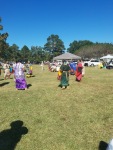
Our next door neighbor Joe is famous for his Jerk Chicken. The perfect recipe for this celebration of family. So give it a try and let me know what you think…. Lisa

Jo’s Jamaican Jerk Chicken
- 10 chicken legs
- ⅓ cup olive oil
- 2 TB light brown sugar, packed
- 1 heaping TB dried thyme
- 2 tsp ground allspice
- 2 tsp smoked paprika
- ¼ – ½ tsp cinnamon
- 1 tsp ground ginger
- 1 tsp ground cloves
- 1 tsp cayenne pepper
- 1 tsp garlic powder
- 1 tsp onion powder
- 2 ¼ tsp kosher salt
- ¼ tsp freshly ground black pepper
- Prepare: Preheat oven to 425F with rack on lower middle position. Use paper towels to thoroughly dry chicken legs of excess moisture. Use fork to poke holes on all sides of chicken legs. Set aside.
- Mix: In a bowl, combine all remaining ingredients to form a spice rub/paste mixture. Evenly rub mixture underneath the skin of chicken legs (easiest to use clean hands to really push the mixture as far underneath skin as you can) as well as on top.
- Bake: Place chicken on large rimmed/foil-lined baking sheet, with space in between each piece. Bake about 40 minutes or until nicely browned. Serve immediately.
Kwanzaa is a time of learning, family and celebration.
During the week of Kwanzaa, families and communities come together to share a feast, to honor the ancestors, affirm the bonds between them, and to celebrate African and African American culture. Each day they light a candle to highlight the principle of that day and to breathe meaning into the principles with various activities, such as reciting the sayings or writings of great black thinkers and writers, reciting original poetry, African drumming, and sharing a meal of African diaspora-inspired foods. The table is decorated with the essential symbols of Kwanzaa, such as the Kinara (Candle Holder), Mkeka (Mat), Muhindi (corn to represent the children), Mazao (fruit to represent the harvest), and Zawadi (gifts). One might also see the colors of the Pan-African flag, red (the struggle), black (the people), and green (the future), represented throughout the space and in the clothing worn by participants. These colors were first proclaimed to be the colors for all people of the African diaspora by Marcus Garvey.













